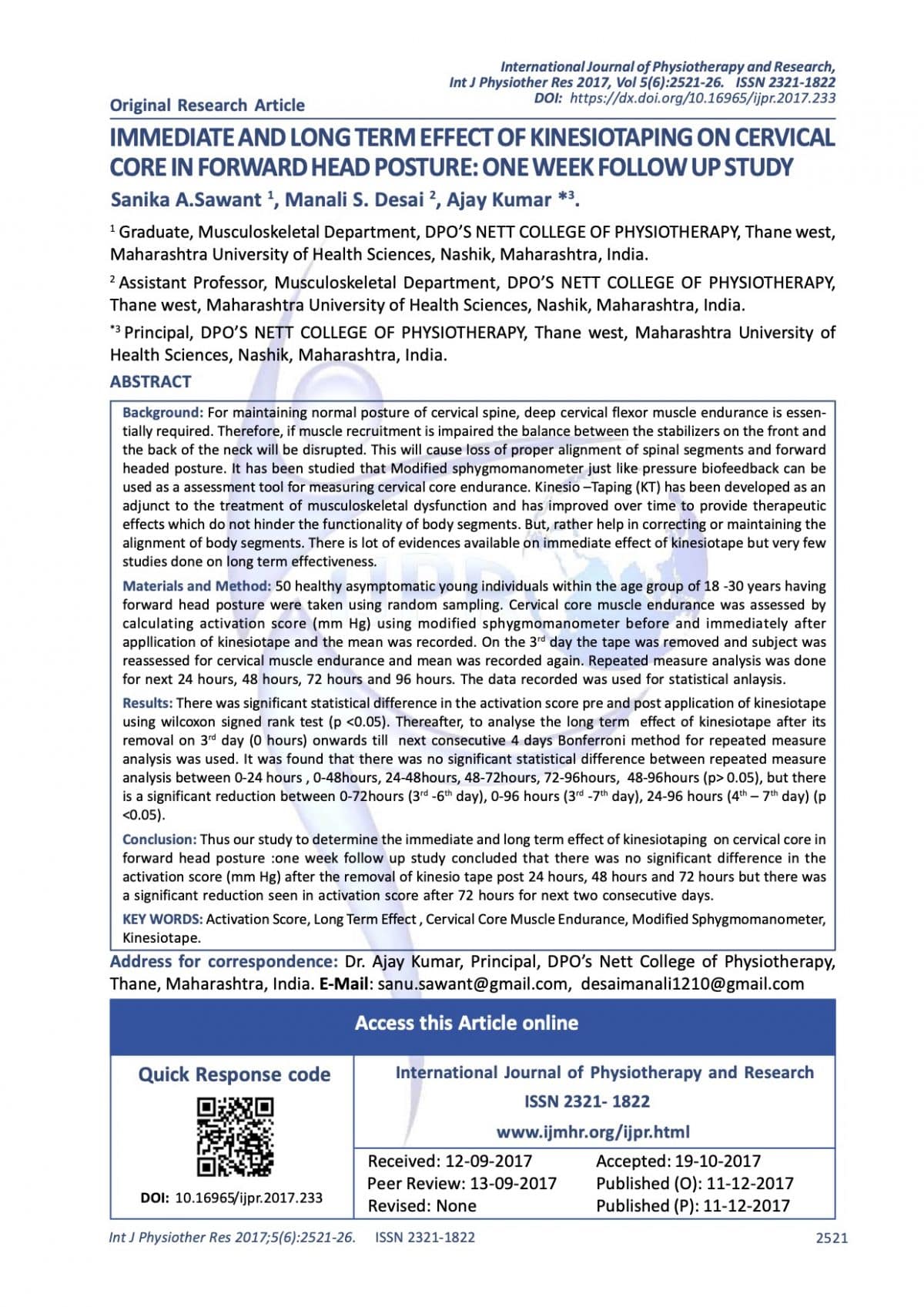IMMEDIATE AND LONG TERM EFFECT OF KINESIOTAPING ON CERVICAL CORE IN FORWARD HEAD POSTURE: ONE WEEK FOLLOW UP STUDY
Sanika A.Sawant 1, Manali S. Desai 2, Ajay Kumar *
Dr. Ajay Kumar, Principal, DPO’s Nett College of Physiotherapy,
Thane, Maharashtra, India. E-Mail: sanu.sawant@gmail.com, desaimanali1210@gmail.com
Abstract
Background-For maintaining normal posture of cervical spine, deep cervical flexor muscle endurance is essentially
required. Therefore, if muscle recruitment is impaired the balance between the stabilizers on the front and the back of the neck will be disrupted. This will cause loss of proper alignment of spinal segments and forward headed posture. It has been studied that Modified sphygmomanometer just like pressure biofeedback can be used as a assessment tool for measuring cervical core endurance. Kinesio –Taping (KT) has been developed as an adjunct to the treatment of musculoskeletal dysfunction and has improved over time to provide therapeutic effects which do not hinder the functionality of body segments. But, rather help in correcting or maintaining the alignment of body segments. There is lot of evidences available on immediate effect of kinesiotape but very few
studies done on long term effectiveness.
Methods/Materials-50 healthy asymptomatic young individuals within the age group of 18 -30 years having forward head posture were taken using random sampling. Cervical core muscle endurance was assessed by calculating activation score (mm Hg) using modified sphygmomanometer before and immediately after application of kinesiotape and the mean was recorded. On the 3rd day the tape was removed and subject was reassessed for cervical muscle endurance and mean was recorded again. Repeated measure analysis was done for next 24 hours, 48 hours, 72 hours and 96 hours. The data recorded was used for statistical analysis.
Results-There was significant statistical difference in the activation score pre and post application of kinesiotape using wilcoxon signed rank test (p <0.05). Thereafter, to analyse the long term effect of kinesiotape after its removal on 3rd day (0 hours) onwards till next consecutive 4 days Bonferroni method for repeated measure
analysis was used. It was found that there was no significant statistical difference between repeated measure analysis between 0-24 hours , 0-48hours, 24-48hours, 48-72hours, 72-96hours, 48-96hours (p> 0.05), but there is a significant reduction between 0-72hours (3rd -6th day), 0-96 hours (3rd -7th day), 24-96 hours (4th – 7th day) (p<0.05).
Conclusion-Thus our study to determine the immediate and long term effect of kinesiotaping on cervical core in forward head posture :one week follow up study concluded that there was no significant difference in the activation score (mm Hg) after the removal of kinesio tape post 24 hours, 48 hours and 72 hours but there was a significant reduction seen in activation score after 72 hours for next two consecutive days.
Keywords-Activation Score, Long Term Effect , Cervical Core Muscle Endurance, Modified Sphygmomanometer, Kinesiotape.




